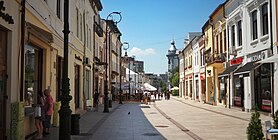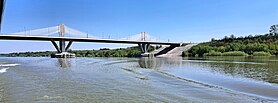Dolj County (Romanian pronunciation: [dolʒ] ⓘ; originally meant Dol(no)-Jiu, "lower Jiu", as opposed to Gorj (upper Jiu))[citation needed] is a county (județ) of Romania on the border with Bulgaria, in Oltenia, with the capital city at Craiova.
Dolj County
Județul Dolj | |
|---|---|
County | |
 | |
| Coordinates: 44°10′N 23°42′E / 44.17°N 23.7°E | |
| Country | |
| Development region1 | Sud-Vest |
| Historic region | Oltenia |
| Capital city | Craiova |
| Government | |
| • Type | County Council |
| • President of the County Council | Vasile Dorin-Cosmin |
| • Prefect2 | Dan Diaconu |
| Area | |
• Total | 7,414 km2 (2,863 sq mi) |
| • Rank | 7th in Romania |
| Population (2021-12-01)[1] | |
• Total | 599,442 |
| • Rank | 7th in Romania |
| • Density | 81/km2 (210/sq mi) |
| Time zone | UTC+2 (EET) |
| • Summer (DST) | UTC+3 (EEST) |
| Postal Code | 20wxyz3 |
| Area code | +40 x514 |
| ISO 3166 code | RO-DJ |
| Car Plates | DJ5 |
| GDP nominal | US$9.400 billion (2024) |
| GDP per capita | US$6,512 (2015) |
| Website | County Council County Prefecture |
| 1 The development regions of Romania have no administrative role and were formed in order to manage funds from the European Union 2 as of 2007, the Prefect is not a politician, but a public functionary. He (or she) is not allowed to be a member of a political party, and is banned from having any political activity in the first six months after his resignation (or exclusion) from the public functionaries' corps. 3w, x, y, and z are digits that indicate the city, the street, part of the street, or even the building of the address 4x is a digit indicating the operator: 2 for the former national operator, Romtelecom, and 3 for the other ground telephone networks 5used on both the plates of the vehicles that operate only in the county limits (like utility vehicles, ATVs, etc.), and the ones used outside the county | |
Demographics
editIn 2011, the county had a population of 660,544 and a population density of 89/km2 (230/sq mi).
| Year | County population[3] |
|---|---|
| 1948 | 615,301 |
| 1956 | 642,028 |
| 1966 | 691,116 |
| 1977 | 750,328 |
| 1992 | 761,074 |
| 2002 | 734,231 |
| 2011 | 660,544 |
| 2021 | 599,442 |
Geography
editThis county has a total area of 7,414 km2 (2,863 sq mi).
The entire area is a plain with the Danube on the south forming a wide valley crossed by the Jiu River in the middle. Other small rivers flow through the county, each one forming a small valley. There are some lakes across the county and many ponds and channels in the Danube valley. 6% of the county's area is a desert.[4]
Neighbours
edit- Olt County to the east.
- Mehedinți County to the west.
- Gorj County and Vâlcea County to the north.
- Bulgaria – Vidin Province to the southwest, Montana and Vratsa provinces to the south.
Economy
editAgriculture is the county's main industry. The county has a land that is ideal for growing cereals, vegetables, and wines. Other industries are mainly located in the city of Craiova, the largest city in southwestern Romania.
The county's main industries:
- Automotive industry – Ford has a factory.
- Heavy electrical and transport equipment – Electroputere Craiova is the largest factory plant in Romania.
- Aeronautics
- Chemicals processing
- Foods and beverages
- Textiles
- Mechanical parts and components
There are two small ports on the shore of the Danube river – Bechet and Calafat.
People
editTourism
editMajor tourist attractions:
Politics
editThe Dolj County Council, renewed at the 2020 local elections, consists of 36 counsellors, with the following party composition:[5]
| Party | Seats | Current County Council | ||||||||||||||||
|---|---|---|---|---|---|---|---|---|---|---|---|---|---|---|---|---|---|---|
| Social Democratic Party (PSD) | 16 | |||||||||||||||||
| National Liberal Party (PNL) | 13 | |||||||||||||||||
| PRO Romania (PRO) | 3 | |||||||||||||||||
| People's Movement Party (PMP) | 2 | |||||||||||||||||
| Ecologist Party of Romania (PER) | 2 | |||||||||||||||||
Administrative divisions
editDolj County 3 municipalities, 4 towns and 104 communes
- Municipalities
- Towns
- Communes
- Afumați
- Almăj
- Amărăștii de Jos
- Amărăștii de Sus
- Apele Vii
- Argetoaia
- Bârca
- Bistreț
- Botoșești-Paia
- Brabova
- Brădești
- Braloștița
- Bratovoești
- Breasta
- Bucovăț
- Bulzești
- Călărași
- Calopăr
- Caraula
- Cârcea
- Cârna
- Carpen
- Castranova
- Catane
- Celaru
- Cerăt
- Cernătești
- Cetate
- Cioroiași
- Ciupercenii Noi
- Coșoveni
- Coțofenii din Dos
- Coțofenii din Față
- Daneți
- Desa
- Dioști
- Dobrești
- Dobrotești
- Drăgotești
- Drănic
- Fărcaș
- Galicea Mare
- Galiciuica
- Gângiova
- Ghercești
- Ghidici
- Ghindeni
- Gighera
- Giubega
- Giurgița
- Gogoșu
- Goicea
- Goiești
- Grecești
- Întorsura
- Ișalnița
- Izvoare
- Leu
- Lipovu
- Măceșu de Jos
- Măceșu de Sus
- Maglavit
- Malu Mare
- Mârșani
- Melinești
- Mischii
- Moțăței
- Murgași
- Negoi
- Orodel
- Ostroveni
- Perișor
- Pielești
- Piscu Vechi
- Plenița
- Pleșoi
- Podari
- Poiana Mare
- Predești
- Radovan
- Rast
- Robănești
- Rojiște
- Sadova
- Sălcuța
- Scăești
- Seaca de Câmp
- Seaca de Pădure
- Secu
- Siliștea Crucii
- Șimnicu de Sus
- Sopot
- Tălpaș
- Teasc
- Terpezița
- Teslui
- Țuglui
- Unirea
- Urzicuța
- Valea Stanciului
- Vârtop
- Vârvoru de Jos
- Vela
- Verbița
Historical county
editJudețul Dolj | |
|---|---|
County (Județ) | |
| The building of the Dolj County prefecture from the interwar period. | |
| Country | Romania |
| Historic region | Oltenia |
| Capital city (Reședință de județ) | Craiova |
| Area | |
• Total | 6,538 km2 (2,524 sq mi) |
| Population (1930) | |
• Total | 485,149 |
| • Density | 74/km2 (190/sq mi) |
| Time zone | UTC+2 (EET) |
| • Summer (DST) | UTC+3 (EEST) |
Historically, the county was located in the southwestern part of Greater Romania, in the southwest part of the historical region of Oltenia. Its capital was Craiova. The interwar county territory comprised the central and southwestern part of the current Dolj county. It was bordered to the north with by the counties of Gorj and Valcea, to the west by Mehedinți County, to the east by Romanați County, and to the south by the Kingdom of Bulgaria.
Administration
editThe county was originally divided into six administrative districts (plăși):[6]
- Plasa Amaradia, headquartered at Melinești
- Plasa Bârca, headquartered at Bârca
- Plasa Calafat, headquartered at Calafat
- Plasa Gângiova, headquartered at Gângiova
- Plasa Ocolul, headquartered at Ocolul
- Plasa Plenița, headquartered at Plenița
Subsequently, four districts were created in place of two of the prior districts (Plasa Bârca and Plasa Gângiova):
- Plasa Bechet, headquartered at Bechet
- Plasa Brabova, headquartered at Brabova
- Plasa Filiași, headquartered at Filiași
- Plasa Segarcea, headquartered at Segarcea
Population
editAccording to the 1930 census data, the county population was 485,149 inhabitants, ethnically divided as follows: 96.7% Romanian, 0.5% Jews, 0.3% Germans, 0.3% Hungarians, as well as other minorities.[7] From the religious point of view, the population was 98.4% Eastern Orthodox, 0.7% Roman Catholic, 0.5% Jewish, as well as other minorities.
Urban population
editIn 1930, the county's urban population was 91,788 inhabitants, comprising 90.2% Romanians, 2.4% Jews, 2.2% Romanies, 1.7% Germans, 1.3% Hungarians, as well as other minorities.[7] From the religious point of view, the urban population was composed of 92.7% Eastern Orthodox, 3.1% Roman Catholic, 2.5% Jewish, 0.7% Lutheran, 0.3% Calvinist, 0.3% Greek Catholic, as well as other minorities.
References
edit- ^ "Populaţia rezidentă după grupa de vârstă, pe județe și municipii, orașe, comune, la 1 decembrie 2021" (XLS). National Institute of Statistics.
- ^ "Populația după etnie" (PDF). National Institute of Statistics. Archived from the original (PDF) on 16 August 2009.
- ^ National Institute of Statistics, "Populația la recensămintele din anii 1948, 1956, 1966, 1977, 1992 și 2002" Archived 22 September 2006 at the Wayback Machine
- ^ "Verde - Avem desertificare. Cum procedam? - Jurnalul National Online". Archived from the original on 26 June 2007. Retrieved 21 June 2007.
- ^ "Rezultatele finale ale alegerilor locale din 2020" (Json) (in Romanian). Autoritatea Electorală Permanentă. Retrieved 2 November 2020.
- ^ Portretul României Interbelice – Județul Dolj
- ^ a b Recensământul general al populației României din 29 decemvrie 1930, Vol. II, pag. 166




